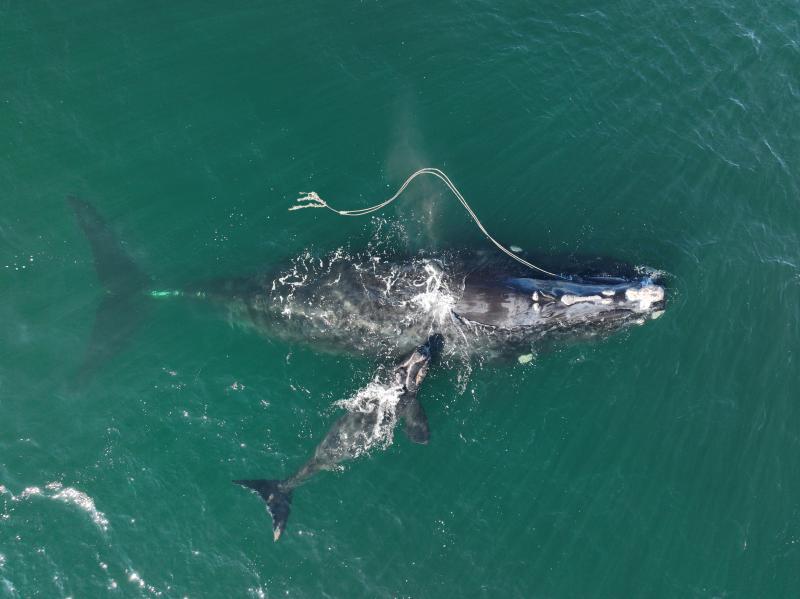
NOAA announces confirmed large whale entanglement numbers in 2021
by NOAA Fisheries 19 Nov 2023 17:26 UTC

An entangled North Atlantic right whale, Snowcone and her calf. Snowcone was first documented as entangled in Cape Cod Bay, MA in March 2021. Snowcone was then documented with a calf during an aerial survey on Dec 2, 2021 near Cumberland Island, Georgia © Georgia Department of Natural Resources; NOAA Permit No. 20556
There were 70 large whale entanglement cases in 2021—an increase from 2020, but below the historical average.
NOAA Fisheries has released the National Report on Large Whale Entanglements Confirmed in the United States in 2021. In 2021, there were 70 confirmed entanglements nationally, which was an increase from 2020 but still below the historical average. Nearly every region of the United States experienced an increase in the number of confirmed large whale entanglements in 2021 when compared to 2020, which had the fewest confirmed large whale entanglements since 2013. The one exception was the Greater Atlantic region, which documented the same number of confirmed large whale entanglements as in 2020.
Many large whale populations are increasing in the United States. However, entanglements in fishing gear or marine debris represent a growing threat to the continued welfare and recovery of these species. Severe entanglements can kill or seriously injure large whales. Entanglements involving threatened or endangered species can have significant negative impacts to the population as a whole.
2021 Entanglements
There were 70 confirmed cases nationally in 2021. This is more than the 53 confirmed large whale entanglement cases in 2020. We don't know what factors may be responsible for the increase in 2021. However, some Covid restrictions (e.g., social distancing) were starting to relax as compared to 2020. As restrictions eased, fishing effort increased, and there were more ocean goers. This could have led to more reports of entangled large whales. The increase in confirmed reports could also reflect the number of entangled large whales in 2021.
The 70 confirmed large whale entanglements in 2021 is below the average annual number of confirmed entanglements over the previous 14 years (annual average was 72). We will continue to analyze data from 2021 to understand whether this dip in confirmed large whale entanglements is temporary (potentially attributable to the Covid pandemic), or part of a longer term downward trend.
Working with Partners
NOAA Fisheries' Marine Mammal Health and Stranding Response Program is proud to work with our partners in the U.S. Large Whale Entanglement Response Network. The Network is composed of highly skilled experts and trained response teams along all coasts. Network members track and document as many of these entanglement incidents as possible.
Scientists and managers use entanglement data to determine the impact of entanglement on individual whales and on populations. They look at different aspects of each entanglement case, including:
- Entanglement rates
- Entanglement severity
- Configuration of the entanglement on the animal
- Type of gear or debris
- Injuries and impact to the animal
Experts use these criteria to evaluate existing management measures and implement new management measures, as warranted, to reduce the threat of entanglement to large whales.
How You Can Help
Members of the public should not attempt to disentangle whales themselves—they should call authorized professional responders instead. Disentangling large whales is a dangerous activity that requires years of training, specialized knowledge, and skills. Experts use customized tools and equipment to ensure the safety of the animals and the response team. Authorized U.S. Large Whale Entanglement Response Network responders can typically remove more of the entangling gear than members of the public. This leads to better outcomes for the whale and improves information gained towards reducing future entanglement threats and impacts. If you encounter an entangled large whale, please call your regional hotline.
Regional Entanglement Hotlines
Maine through Virginia: (866) 755-6622
North Carolina through Texas: (877) 942-5343
California, Oregon, and Washington: (877) SOS-WHALe (877-767-9425)
Alaska: (877) 925-7773
Hawaii: (888) 256-9840